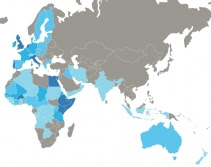The Daily Nation: Reliable Data Can Aid Fight Against Female Genital Mutilation
 |
| Jacinta Muteshi-Strachan 13 February 2018 |
*This op-ed was orinially published in the Feb. 6th print edition of The Daily Nation, the Kenyan newspaper.
There are many things we know – with certainty – about female genital mutilation/cutting (FGM/C). We know that more than 200 million women and girls in the world have undergone FGM/C. We know that it happens in parts of Kenya – and that it is against the law in this country. While the evidence of FGM/C’s physical and mental harms is well-documented, we know there are people who support it as a cultural practice. We also know that many people are against it: people who see an obligation to respect the human rights of girls and women.
We’re learning more about FGM/C – where it happens, why it happens, how it’s shifting, opportunities for abandonment – than we’ve ever known before. For the first time in Kenya, we’re able to go beyond national data and understand what’s happening on a local and community level. Only with a nuanced, evidence-based approach to FGM/C will we be able to lay the foundations for a Kenya where no girl is subjected to a cut.
As we mark International Day of Zero Tolerance for FGM/C, we’re taking stock of these new insights. The national prevalence of FGM/C in Kenya has gone down from an estimated 38% of women in 1998 to 21% in 2014. But still, the data shows us there are parts of Kenya where change is slow or non-existent. In Garissa, Kisii, Mandera and Wajir counties, rates of FGM/C remain persistently high. Isiolo county has recently seen an increase. At the same time, we see progress and small reductions in FGM/C in Nyamira and Samburu counties, and amongst the Maasai in Narok and Kajiado counties.
And yet, there is still a lot we do not understand about FGM/C. Why, for instance, has FGM/C reduced in Nyamira and remained high in neighbouring Kisii county? What’s getting in the way of progress in counties in North-eastern Kenya? And what are we getting right in Narok? We need to continue to seek answers to these questions so that we can say, with certainty, what it is that is creating change, or keeping things the way they are.
What I do know, after over a decade of research into FGM/C, is that we are finally beginning to produce good research that will support more positive approaches to girls and women’s empowerment and abandonment of FGM/C. Working with communities and organizations across Kenya and beyond, our African-led Evidence to End FGM/C Research Programme is on a quest for reliable, actionable data.
With good data, national and county governments can work more closely with communities to address their issues and track any changes that are happening. For example, in Kenya, we are seeing higher FGM/C in rural areas than urban; different rates of cutting amongst daughters of women with no education as compared to those with more-educated mothers; and different rates of FGM/C based on ethnicity, religion and household wealth. Our data also shows a trend towards cutting girls at younger ages than previous generations and that more girls are being cut by healthcare professionals.
This knowledge helps us have more candid and targeted discussions about FGM/C and what needs to be done. Rigorous evidence puts us in a better position to talk about how cultures are always changing and will continue to change and how we, together, can contribute to the abandonment of FGM/C. Though advocacy, policy and legal actions on FGM/C are essential, they must be guided by reliable research or they risk having unmeasured or unintended effects.


